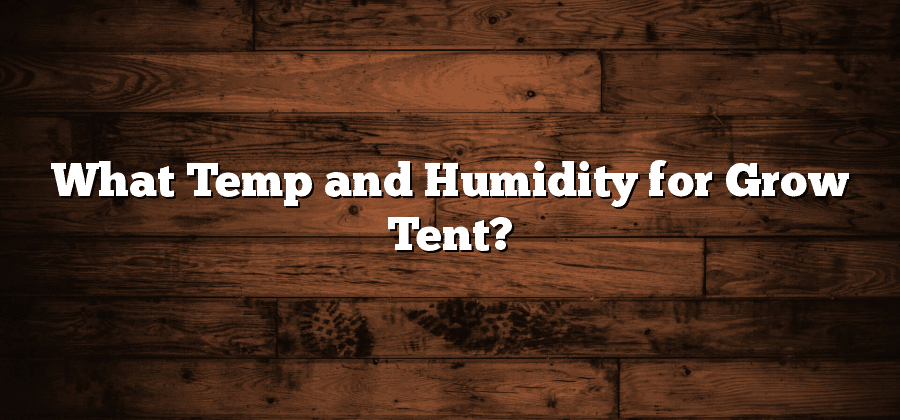Ideal Temperature for a Grow Tent
Temperature plays a vital role in the successful growth of plants in a grow tent. It is essential to maintain an ideal temperature range to create a favorable environment for your plants. The ideal temperature for a grow tent typically falls between 70°F and 85°F (21°C and 29°C). However, it is important to note that certain plant species may require specific temperature ranges for optimal growth. Sudden temperature fluctuations or prolonged exposure to extreme temperatures can have negative effects on plant growth and development.
Maintaining the ideal temperature in a grow tent can be achieved through various methods such as using ventilation systems, exhaust fans, and temperature control devices. A well-ventilated grow tent allows for the exchange of fresh air, preventing heat buildup that could potentially harm the plants. Additionally, using a grow light of appropriate wattage and positioning it at the correct distance from the plants can help regulate the temperature within the tent. Regular monitoring and adjustment of the temperature are paramount to create a stable and suitable environment for your plants to thrive in the grow tent.
Ideal Humidity Levels for a Grow Tent
Maintaining the ideal humidity levels in a grow tent is crucial for the success of your plants. The humidity level refers to the amount of moisture present in the air, and it plays a significant role in the overall growth and development of your plants. Too much or too little humidity can have adverse effects on your plants, leading to stunted growth, fungal diseases, and a decrease in yield.
The ideal humidity level for a grow tent depends on the stage of plant growth. During the early stages, such as germination and seedling growth, a humidity level of around 70-80% is recommended. This high humidity helps to keep the soil and plant tissues moist, promoting healthy root development. As the plants mature, it is essential to gradually decrease the humidity level to around 40-60%. This lower humidity level prevents the growth of mold and mildew, which can be detrimental to the health of your plants. Remember, maintaining the ideal humidity levels in your grow tent is a delicate balancing act, but with proper monitoring and adjustments, you can ensure optimal conditions for your plants’ growth.
Understanding the Relationship between Temperature and Humidity
Temperature and humidity are two vital factors that heavily influence the success of a grow tent. Understanding the relationship between these two variables is crucial for maintaining optimal growing conditions for plants. As temperature rises, the air has the ability to hold more moisture, resulting in lower humidity levels. Conversely, when temperature decreases, the capacity of the air to hold moisture decreases, resulting in higher humidity levels. This reciprocal relationship between temperature and humidity underscores the need for growers to find the right balance to ensure healthy plant growth.
When the temperature and humidity levels are not properly regulated, it can lead to undesirable consequences for plants. High temperatures coupled with high humidity can create a breeding ground for mold and pests, while low temperatures paired with low humidity can cause stunted growth and stress on plants. By understanding the delicate interplay between temperature and humidity, growers can make informed decisions to create an optimal environment for their plants. This involves not only monitoring these variables but also adjusting them to align with the specific needs of the plants being cultivated.
Factors Affecting Temperature and Humidity in a Grow Tent
Factors Affecting Temperature and Humidity in a Grow Tent
There are several key factors that can affect the temperature and humidity levels in a grow tent, ultimately impacting the success of your plant cultivation. One of the primary factors to consider is the grow light intensity. The type and power of your grow lights will significantly influence the temperature inside the tent. High-intensity lights tend to generate more heat, which can raise the temperature in the grow tent. On the other hand, lower-intensity lights may not produce enough heat to maintain an optimal temperature for plant growth. It is crucial to find the right balance between light intensity and temperature to ensure a favorable environment for your plants.
Another critical factor affecting temperature and humidity is the ventilation system. Proper airflow and ventilation play a vital role in maintaining the ideal conditions inside the grow tent. Insufficient airflow can lead to an increase in temperature and humidity, creating a breeding ground for pests and diseases. On the contrary, excessive ventilation can result in a drop in temperature and humidity levels, potentially stunting plant growth. Finding the right balance between air circulation and maintaining the desired temperature and humidity is crucial for the overall health and development of your plants.
The Importance of Controlling Temperature and Humidity in a Grow Tent
Having the ability to control temperature and humidity levels in a grow tent is crucial for any successful indoor gardening operation. The health and growth of plants depend heavily on maintaining optimal conditions within the growing environment. Temperature and humidity play interconnected roles in plant development, affecting everything from seed germination to flowering and fruit production.
When it comes to temperature, it is essential to keep it within the ideal range for the specific plants being cultivated. High temperatures can lead to stress, dehydration, and even plant death, while low temperatures can slow down growth and promote the development of diseases. Similarly, humidity levels must be carefully monitored and adjusted to prevent issues like mold, mildew, and other fungal infections. By controlling both temperature and humidity, growers can create an environment that promotes healthy plant growth and maximizes crop yields.






